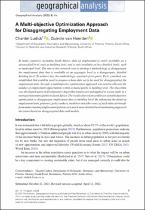JavaScript is disabled for your browser. Some features of this site may not work without it.
- ResearchSpace
- →
- Research Publications/Outputs
- →
- Journal Articles
- →
- View Item
| dc.contributor.author |
Ludick, Chantel J

|
|
| dc.contributor.author |
Van Heerden, Quintin

|
|
| dc.date.accessioned | 2022-08-19T07:48:32Z | |
| dc.date.available | 2022-08-19T07:48:32Z | |
| dc.date.issued | 2022-07 | |
| dc.identifier.citation | Ludick, C.J. & Van Heerden, Q. 2022. A multi-objective optimization approach for disaggregating employment data. <i>Geographical Analysis.</i> http://hdl.handle.net/10204/12475 | en_ZA |
| dc.identifier.issn | 0016-7363 | |
| dc.identifier.issn | 1538-4632 | |
| dc.identifier.uri | https://doi.org/10.1111/gean.12328 | |
| dc.identifier.uri | http://hdl.handle.net/10204/12475 | |
| dc.description.abstract | In many countries, including South Africa, data on employment is rarely available on a downscaled level, such as building level, and is only available on less detailed levels, such as municipal level. The aim of this research was to develop a methodology to disaggregate the employment data that is available at an aggregate level to a disaggregate, detailed building level. To achieve this, the methodology consisted of two parts. First, a method was established that could be used to prepare a base data set to be used for disaggregating the employment data. Second, a multiobjective optimization approach was used to allocate the number of employment opportunities within a municipality to building level. The algorithm was developed using an Evolutionary Algorithm framework and applied to a case study in a metropolitan municipality in South Africa. The results showed favorable use of multiobjective optimization to disaggregate employment data to building level. By enhancing the detail of employment data, planners, policy makers, modelers and other users of such data can benefit from understanding employment patterns at a much more detailed level and making improved decisions based on disaggregated data and models. | en_US |
| dc.format | Fulltext | en_US |
| dc.language.iso | en | en_US |
| dc.relation.uri | https://onlinelibrary.wiley.com/doi/full/10.1111/gean.12328 | en_US |
| dc.source | Geographical Analysis | en_US |
| dc.subject | Employment data | en_US |
| dc.subject | Employment data disaggregating | en_US |
| dc.title | A multi-objective optimization approach for disaggregating employment data | en_US |
| dc.type | Article | en_US |
| dc.description.pages | 25 | en_US |
| dc.description.note | © 2022 The Authors. Geographical Analysis published by Wiley Periodicals LLC on behalf of The Ohio State University. This is an open access article under the terms of the Creative Commons Attribution-NonCommercial License, which permits use, distribution and reproduction in any medium, provided the original work is properly cited and is not used for commercial purposes. | en_US |
| dc.description.cluster | Smart Places | en_US |
| dc.description.impactarea | Urban and Regional Dynamics | en_US |
| dc.identifier.apacitation | Ludick, C. J., & Van Heerden, Q. (2022). A multi-objective optimization approach for disaggregating employment data. <i>Geographical Analysis</i>, http://hdl.handle.net/10204/12475 | en_ZA |
| dc.identifier.chicagocitation | Ludick, Chantel J, and Quintin Van Heerden "A multi-objective optimization approach for disaggregating employment data." <i>Geographical Analysis</i> (2022) http://hdl.handle.net/10204/12475 | en_ZA |
| dc.identifier.vancouvercitation | Ludick CJ, Van Heerden Q. A multi-objective optimization approach for disaggregating employment data. Geographical Analysis. 2022; http://hdl.handle.net/10204/12475. | en_ZA |
| dc.identifier.ris | TY - Article AU - Ludick, Chantel J AU - Van Heerden, Quintin AB - In many countries, including South Africa, data on employment is rarely available on a downscaled level, such as building level, and is only available on less detailed levels, such as municipal level. The aim of this research was to develop a methodology to disaggregate the employment data that is available at an aggregate level to a disaggregate, detailed building level. To achieve this, the methodology consisted of two parts. First, a method was established that could be used to prepare a base data set to be used for disaggregating the employment data. Second, a multiobjective optimization approach was used to allocate the number of employment opportunities within a municipality to building level. The algorithm was developed using an Evolutionary Algorithm framework and applied to a case study in a metropolitan municipality in South Africa. The results showed favorable use of multiobjective optimization to disaggregate employment data to building level. By enhancing the detail of employment data, planners, policy makers, modelers and other users of such data can benefit from understanding employment patterns at a much more detailed level and making improved decisions based on disaggregated data and models. DA - 2022-07 DB - ResearchSpace DP - CSIR J1 - Geographical Analysis KW - Employment data KW - Employment data disaggregating LK - https://researchspace.csir.co.za PY - 2022 SM - 0016-7363 SM - 1538-4632 T1 - A multi-objective optimization approach for disaggregating employment data TI - A multi-objective optimization approach for disaggregating employment data UR - http://hdl.handle.net/10204/12475 ER - | en_ZA |
| dc.identifier.worklist | 25901 | en_US |






